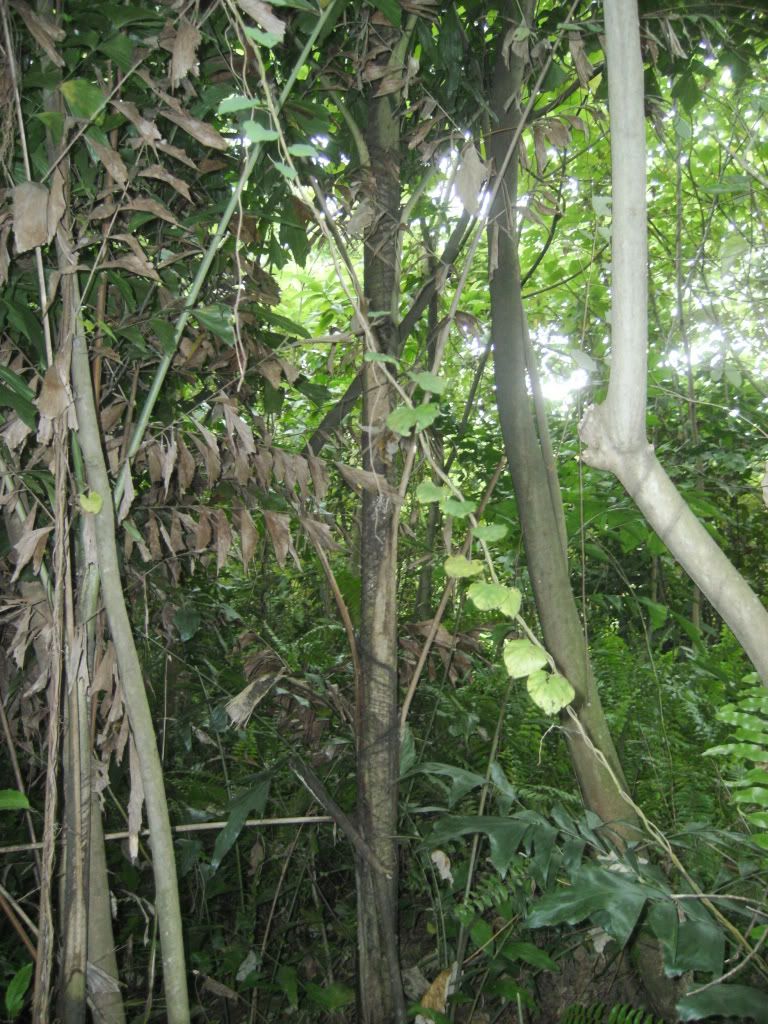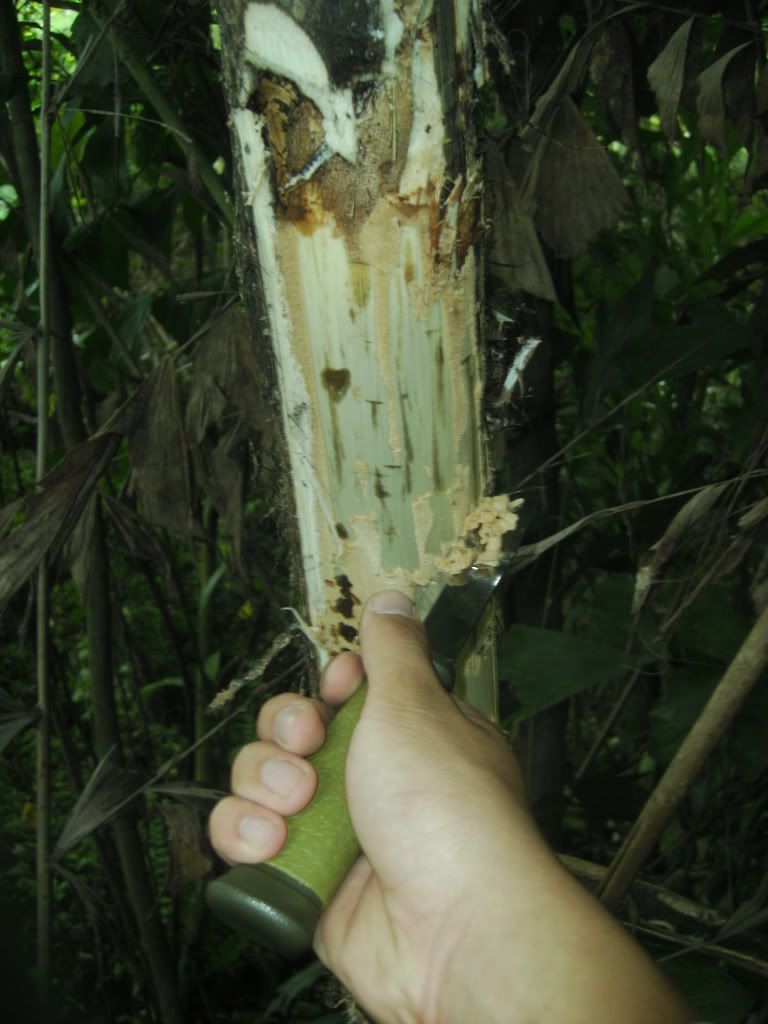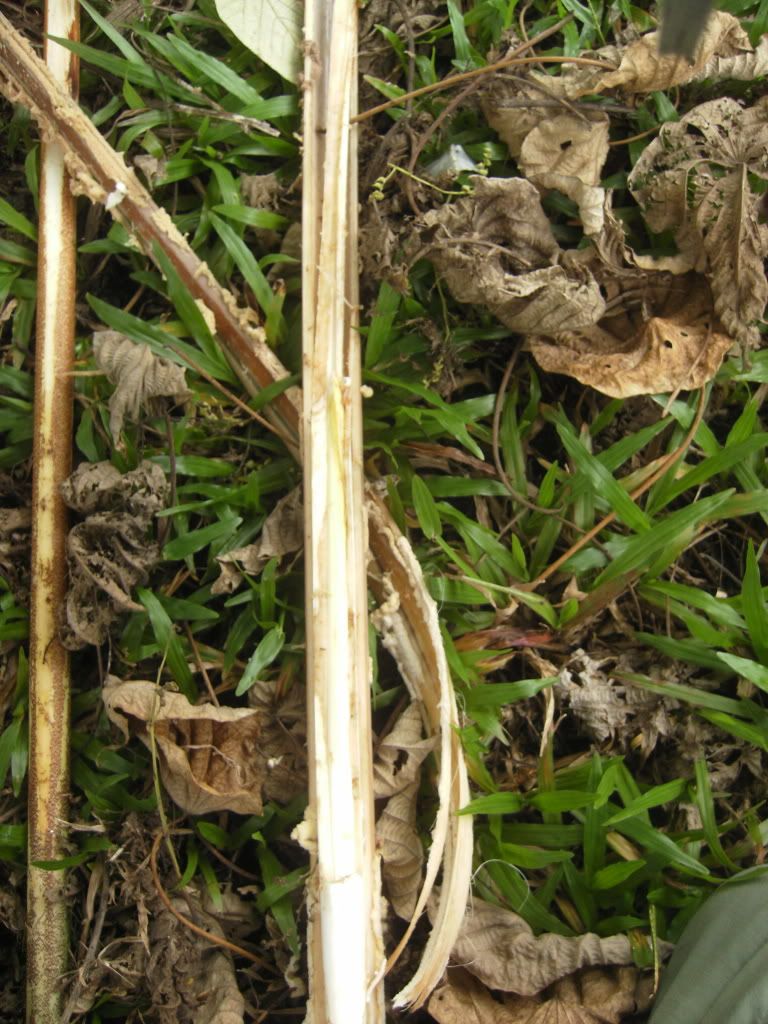Fish Tail Palm Produce
Fish Tail Palm(Caryota Urens) is native to the tropical rainforests, jungles and hill country of South East Asia .It can be found from India all the way down to Indonesia and the Philippines. Its found its place in America as an ornamental plant, but most people are unaware of what it can provide you with.

FIRE
Unknown to most, there is a cotton-like substance on the inside of the bark of the palm. This can be harvested by taking a leaf off and collecting the fluff. To get a larger amount, get a machete/parang and take an angled cut on the trunk at about chest level and then a horizontal one to pop a chunk off, then squeeze your machete down the gap and move it from side to side to get the bark off. When you get to an orangey cotton, pull off the bark and repeat on another section until you have about half the palms bark off then scrape the cotton off with a knife in a downward motion. When dry, it can take a spark and smolder for a long time if left. When mixed in a 1:2 ratio of charcloth and cotton it is a very good fire starter. To prepare this, tear the charcloth and cotton together into small pieces and place in jar, then shake vigorously and you should get an end product like this. If dry, it will catch the first spark you give it, even with flint!
 what the "cotton" looks like.
what the "cotton" looks like.
 harvesting it with my Mora.
harvesting it with my Mora.
Shelter
Although not the best shape for making a roof for your shelter, when inverted, the leaves (like most palms) will channel water down and away, so when you inter-weave them, water will be channeled downwards. The roof has to be a slanting one though!
Food
The berries of this palm are poisonous ,although not deadly they cause severe mouth irritation because they contain calcium oxalate crystals (believe me Ive tried!), having a stomach ache in a survival situation could be deadly. The seeds/kernels of the fruit are edible after boiling for a couple minutes (handling the berries does cause slight itch, not permanent) choose only the ripe berries (yellow/red). The heart of palm is good when boiled, its very starchy but very filling. It can be extracted by cutting down the palm (2-8 inch across is good) then removing the stems by chopping off the branches and running a knife down the trunk to remove a portion. After trimming off all the sides (save the cotton!) you will land up with the heart ,a white long stem. I recommend boiling with the seeds/kernels and pouring the water away as its not fit for drinking.
 heart of the palm.
heart of the palm.
Other Uses
Natives of Malaysia use the cotton as wadding for their blowpipes, when inserted behind the dart and it increases the muzzle velocity drastically. The lower part of the leaf can be made into baskets,bowls or sheaths for knives.
Precautions
Make sure you wash your hands after cutting a fish tail palm down as touching something (or somewhere!) like a canteen mouth would cause irritation when you drink. Dont eat the seeds!! I have seen and heard of a few people getting in a bad way after eating them, and since they are an ornamental plant, they could get eaten accidentally, especially by children.
I just thought I would post this up for people interested in asian plant species that are useful.
Fish Tail Palm(Caryota Urens) is native to the tropical rainforests, jungles and hill country of South East Asia .It can be found from India all the way down to Indonesia and the Philippines. Its found its place in America as an ornamental plant, but most people are unaware of what it can provide you with.

FIRE
Unknown to most, there is a cotton-like substance on the inside of the bark of the palm. This can be harvested by taking a leaf off and collecting the fluff. To get a larger amount, get a machete/parang and take an angled cut on the trunk at about chest level and then a horizontal one to pop a chunk off, then squeeze your machete down the gap and move it from side to side to get the bark off. When you get to an orangey cotton, pull off the bark and repeat on another section until you have about half the palms bark off then scrape the cotton off with a knife in a downward motion. When dry, it can take a spark and smolder for a long time if left. When mixed in a 1:2 ratio of charcloth and cotton it is a very good fire starter. To prepare this, tear the charcloth and cotton together into small pieces and place in jar, then shake vigorously and you should get an end product like this. If dry, it will catch the first spark you give it, even with flint!


Shelter
Although not the best shape for making a roof for your shelter, when inverted, the leaves (like most palms) will channel water down and away, so when you inter-weave them, water will be channeled downwards. The roof has to be a slanting one though!
Food
The berries of this palm are poisonous ,although not deadly they cause severe mouth irritation because they contain calcium oxalate crystals (believe me Ive tried!), having a stomach ache in a survival situation could be deadly. The seeds/kernels of the fruit are edible after boiling for a couple minutes (handling the berries does cause slight itch, not permanent) choose only the ripe berries (yellow/red). The heart of palm is good when boiled, its very starchy but very filling. It can be extracted by cutting down the palm (2-8 inch across is good) then removing the stems by chopping off the branches and running a knife down the trunk to remove a portion. After trimming off all the sides (save the cotton!) you will land up with the heart ,a white long stem. I recommend boiling with the seeds/kernels and pouring the water away as its not fit for drinking.

Other Uses
Natives of Malaysia use the cotton as wadding for their blowpipes, when inserted behind the dart and it increases the muzzle velocity drastically. The lower part of the leaf can be made into baskets,bowls or sheaths for knives.
Precautions
Make sure you wash your hands after cutting a fish tail palm down as touching something (or somewhere!) like a canteen mouth would cause irritation when you drink. Dont eat the seeds!! I have seen and heard of a few people getting in a bad way after eating them, and since they are an ornamental plant, they could get eaten accidentally, especially by children.
I just thought I would post this up for people interested in asian plant species that are useful.









